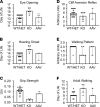Efficacy of AAV9-mediated SGPL1 gene transfer in a mouse model of S1P lyase insufficiency syndrome
- PMID: 33755599
- PMCID: PMC8119223
- DOI: 10.1172/jci.insight.145936
Efficacy of AAV9-mediated SGPL1 gene transfer in a mouse model of S1P lyase insufficiency syndrome
Abstract
Sphingosine-1-phosphate lyase insufficiency syndrome (SPLIS) is a rare metabolic disorder caused by inactivating mutations in sphingosine-1-phosphate lyase 1 (SGPL1), which is required for the final step of sphingolipid metabolism. SPLIS features include steroid-resistant nephrotic syndrome and impairment of neurological, endocrine, and hematopoietic systems. Many affected individuals die within the first 2 years. No targeted therapy for SPLIS is available. We hypothesized that SGPL1 gene replacement would address the root cause of SPLIS, thereby serving as a universal treatment for the condition. As proof of concept, we evaluated the efficacy of adeno-associated virus 9-mediated transfer of human SGPL1 (AAV-SPL) given to newborn Sgpl1-KO mice that model SPLIS and die in the first weeks of life. Treatment dramatically prolonged survival and prevented nephrosis, neurodevelopmental delay, anemia, and hypercholesterolemia. STAT3 pathway activation and elevated proinflammatory and profibrogenic cytokines observed in KO kidneys were attenuated by treatment. Plasma and tissue sphingolipids were reduced in treated compared with untreated KO pups. SGPL1 expression and activity were measurable for at least 40 weeks. In summary, early AAV-SPL treatment prevents nephrosis, lipidosis, and neurological impairment in a mouse model of SPLIS. Our results suggest that SGPL1 gene replacement holds promise as a durable and universal targeted treatment for SPLIS.
Keywords: Gene therapy; Genetic diseases; Metabolism; Therapeutics.
Conflict of interest statement
Figures












Similar articles
-
AAV-SPL 2.0, a Modified Adeno-Associated Virus Gene Therapy Agent for the Treatment of Sphingosine Phosphate Lyase Insufficiency Syndrome.Int J Mol Sci. 2023 Oct 25;24(21):15560. doi: 10.3390/ijms242115560. Int J Mol Sci. 2023. PMID: 37958544 Free PMC article.
-
Genotype/Phenotype Interactions and First Steps Toward Targeted Therapy for Sphingosine Phosphate Lyase Insufficiency Syndrome.Cell Biochem Biophys. 2021 Sep;79(3):547-559. doi: 10.1007/s12013-021-01013-9. Epub 2021 Jun 16. Cell Biochem Biophys. 2021. PMID: 34133011 Review.
-
Sphingosine phosphate lyase insufficiency syndrome (SPLIS): A novel inborn error of sphingolipid metabolism.Adv Biol Regul. 2019 Jan;71:128-140. doi: 10.1016/j.jbior.2018.09.004. Epub 2018 Sep 25. Adv Biol Regul. 2019. PMID: 30274713 Free PMC article. Review.
-
Responsiveness of sphingosine phosphate lyase insufficiency syndrome to vitamin B6 cofactor supplementation.J Inherit Metab Dis. 2020 Sep;43(5):1131-1142. doi: 10.1002/jimd.12238. Epub 2020 May 4. J Inherit Metab Dis. 2020. PMID: 32233035 Free PMC article.
-
Sphingosine phosphate lyase insufficiency syndrome as a primary immunodeficiency state.Adv Biol Regul. 2024 Dec;94:101058. doi: 10.1016/j.jbior.2024.101058. Epub 2024 Oct 22. Adv Biol Regul. 2024. PMID: 39454238 Review.
Cited by
-
Sphingosine Phosphate Lyase Is Upregulated in Duchenne Muscular Dystrophy, and Its Inhibition Early in Life Attenuates Inflammation and Dystrophy in Mdx Mice.Int J Mol Sci. 2022 Jul 8;23(14):7579. doi: 10.3390/ijms23147579. Int J Mol Sci. 2022. PMID: 35886926 Free PMC article.
-
Sphingosine phosphate lyase insufficiency syndrome: a systematic review.World J Pediatr. 2023 May;19(5):425-437. doi: 10.1007/s12519-022-00615-4. Epub 2022 Nov 12. World J Pediatr. 2023. PMID: 36371483
-
Clinical presentation and management challenges of sphingosine-1-phosphate lyase insufficiency syndrome associated with an SGPL1 variant: a case report.BMC Pediatr. 2025 Jan 4;25(1):1. doi: 10.1186/s12887-024-05311-y. BMC Pediatr. 2025. PMID: 39755650 Free PMC article.
-
AAV-SPL 2.0, a Modified Adeno-Associated Virus Gene Therapy Agent for the Treatment of Sphingosine Phosphate Lyase Insufficiency Syndrome.Int J Mol Sci. 2023 Oct 25;24(21):15560. doi: 10.3390/ijms242115560. Int J Mol Sci. 2023. PMID: 37958544 Free PMC article.
-
Neurological Consequences of Sphingosine Phosphate Lyase Insufficiency.Front Cell Neurosci. 2022 Sep 14;16:938693. doi: 10.3389/fncel.2022.938693. eCollection 2022. Front Cell Neurosci. 2022. PMID: 36187293 Free PMC article. Review.
References
Publication types
MeSH terms
Substances
Grants and funding
LinkOut - more resources
Full Text Sources
Other Literature Sources
Medical
Molecular Biology Databases
Research Materials
Miscellaneous

